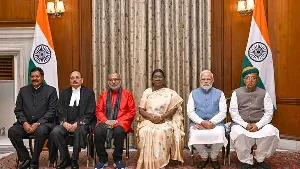India's Economic Growth Forecast at 6.5–6.7% Amid Trade Challenges

India's economic outlook remains optimistic, with S&P Global Ratings forecasting a growth rate of 6.5 per cent for the current fiscal year 2026 and an increase to 6.7 per cent in fiscal year 2027. This projection reflects expectations of sustained growth driven primarily by domestic consumption, despite ongoing pressures from elevated tariffs imposed by the United States.
S&P's assessment is supported by recent economic indicators, including a notable 7.8 per cent growth in India's real Gross Domestic Product (GDP) during the April to June quarter, marking the fastest growth rate in five quarters. Official GDP data for the July to September period is scheduled for release on November 28, 2025.
The agency highlighted that the combination of tax cuts and an easing of monetary policy is expected to bolster household consumption. Among the significant changes, the Indian government has raised the income-tax rebate ceiling from ₹7 lakh to ₹12 lakh, thereby increasing disposable income for middle-class families. The Reserve Bank of India (RBI) also reduced interest rates by 50 basis points earlier this year, bringing them to a three-year low of 5.5 per cent. Furthermore, the Goods and Services Tax (GST) rates on a wide range of mass-consumption items were lowered, making essential goods more affordable.
S&P noted that these policy shifts are likely to enhance consumer spending, which currently constitutes more than half of India's GDP. The agency anticipates that domestic consumption will play a more significant role in economic growth compared to investment in the upcoming fiscal years.
In addition to fiscal measures, a favourable monsoon season has contributed positively to agricultural output, thereby boosting rural incomes. This is expected to further stimulate demand within the economy. S&P predicts inflation to moderate around 3.2 per cent, which would enhance real purchasing power for households.
Despite the positive outlook, S&P cautioned that India's export-oriented sectors are facing considerable challenges due to high tariffs from the United States, which continue to hinder the manufacturing sector's potential contribution to economic growth. The agency pointed out that the current trade environment could divert focus away from productivity improvements as businesses and governments seek exemptions from tariffs.
S&P suggested that securing a trade agreement with the US could alleviate some of this uncertainty, particularly benefiting labour-intensive industries. However, the ratings agency also expressed concerns that continued weaknesses in exports could limit job creation and investment in manufacturing.
The investment landscape remains a critical area for observation, as while government spending on infrastructure projects continues, private investment has not yet shown significant acceleration. Economists have raised concerns that a heavy reliance on consumer spending without a corresponding rise in capital investment could hinder productivity growth, making it challenging for India to achieve the higher growth rates necessary for long-term development goals.
In the current macroeconomic context, S&P believes that the RBI may have the flexibility to implement additional rate cuts if economic conditions warrant, further easing financing for both consumers and businesses. The agency has noted that India’s fiscal policies, while accommodating tax relief, have generally remained within manageable limits, contributing to the overall positive sentiment towards the economy.
For businesses, this consumption-driven cycle is expected to create robust demand in sectors such as retail, consumer durables, and hospitality. Conversely, companies that rely heavily on exports may face a challenging environment unless domestic demand can offset the impacts of international trade barriers.
In summary, S&P Global Ratings' outlook reflects confidence in India's ability to sustain economic growth through internal demand drivers. However, the agency emphasises the importance of enhancing investment and reducing external vulnerabilities to achieve higher growth trajectories in the future.

Supreme Court to Review Sonam Wangchuk's Detention on November 24

Afghanistan Offers Five-Year Tax Breaks for Indian Investors

Mamata Banerjee Raises Concerns Over Election Commission Decisions

Legacy of Dharmendra Lives On with His Last Film 'Ikkis'





